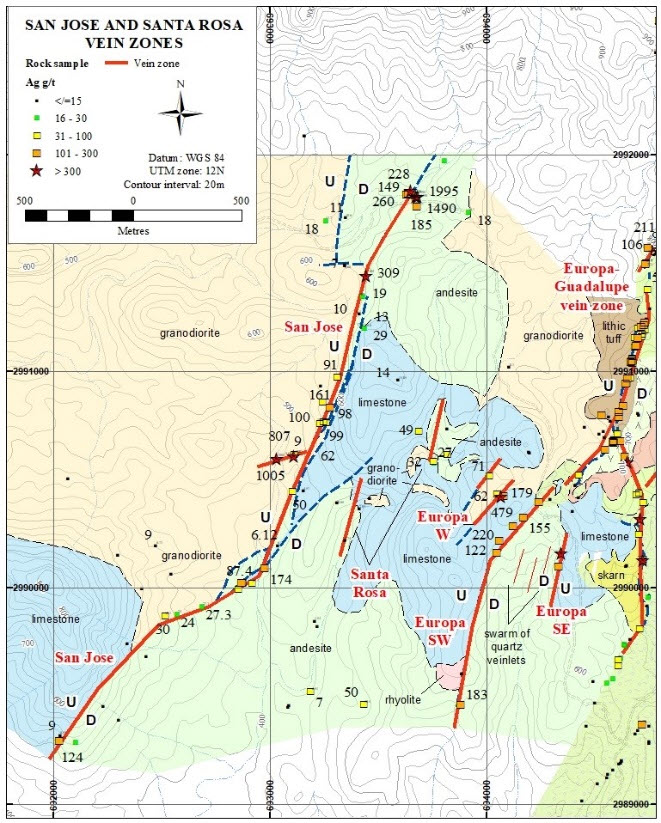Minaurum Gold, Inc., (“Minaurum”) is pleased to announce the discovery of two new vein zones, the San Jose and the Santa Rosa, through its ongoing district-scale reconnaissance program. San José returned assays ranging from anomalous up to 1995 g/t Ag, 2.46% Cu and 1.93% Pb and along with Santa Rosa lies in the western portion of the recently acquired Claraboya concession. (see News Release dated October 23, 2018)
“San José represents one of the largest and highest-grade new vein zones we’ve found at Alamos, with grades and widths that bode well for the potential at depth and along strike. We expect to test this new target in our current drill program.” stated Darrell Rader, President and CEO of Minaurum.
Drill Program Update:
In addition to its ongoing surface reconnaissance program, Minaurum is the midst of a minimum 5,000 m drill program at Alamos, employing one man-portable drill rig. The holes planned and drilled to date are up to 900m long, drilled at shallow-angles to maximize the possibility of encountering high angle vein zones, including veins with little or no surface expression (blind veins). Holes have been averaging three to four weeks to complete; Heavy rains in September delayed drilling on numerous occasions. Minaurum anticipates having its first batch of results ready for release within the next 6-8 weeks.
San José Vein
The 3 km-long NNE-striking, steeply SE-dipping San José vein zone is hosted in a fault zone with displacements similar to those seen in the Europa-Guadalupe vein and the historically productive La Quintera-Promontorio vein. The fault zone appears to be the western bounding fault of a complex horst-and-graben system that controls the emplacement of mineralized veins. Host rocks include limestone, granodiorite and andesites. The fault zone measures 10-20 meters in width and contains several individual 1-2 m veins within it. (Table 1, Figure 2). Historic exploration workings are present at San José but do not appear to have been developed for more than a few tens of meters from surface.
Santa Rosa Vein
The Santa Rosa vein zone is marked by stringer-quartz veinlets with visible Cu-oxide mineralization up to 300 metres in strike length. Rock sample assay results from these vein zones are listed in Table 1 and vein zone locations in Figure 2.
Table 1. Rock geochemical sampling, San José and Santa Rosa vein zones.
Type | Vein | Width | Ag | Au | Cu | Pb | Zn | ||
Grab | San Jose |
| 384 | 56 | 0.32 | 0.12 | 0.74 | ||
Outcrop | San Jose | 0.5 | 260 | 16 | 0.44 | 0.36 | 0.67 | ||
Outcrop | San Jose | 0.3 | 228 | 62 | 0.88 | 0.34 | 0.52 | ||
Outcrop | San Jose | 0.3 | 1490 | 131 | 2.38 | 0.63 | 0.89 | ||
Outcrop | San Jose | 0.4 | 1995 | 38 | 1.91 | 0.04 | 0.13 | ||
Outcrop | San Jose | 0.9 | 185 | 163 | 0.46 | 0.66 | 0.92 | ||
Dump | San Jose |
| 70 | 116 | 0.05 | 0.05 | 0.19 | ||
Outcrop | San Jose | 1.3 | 62 | 16 | 0.28 | 0.30 | 0.25 | ||
Dump | San Jose |
| 807 | 702 | 2.46 | 0.19 | 0.37 | ||
Dump | San Jose |
| 1005 | 5 | 0.90 | 0.23 | 0.18 | ||
Outcrop | San Jose | 1.5 | 50 | 10 | 0.17 | 0.01 | 0.04 | ||
Outcrop | San Jose | 1.3 | 174 | 6 | 0.12 | 0.20 | 0.28 | ||
Outcrop | San Jose |
| 116 | 33 | 0.47 | 0.06 | 0.05 | ||
Outcrop | San Jose | 1.5 | 52 | 34 | 0.16 | 0.09 | 0.09 | ||
Outcrop | San Jose | 1.0 | 46 | 45 | 0.14 | 0.01 | 0.04 | ||
Dump | San Jose |
| 87 | 12 | 0.06 | 1.93 | 0.63 | ||
Float | San Jose |
| 83 | 321 | 0.31 | 0.12 | 0.14 | ||
Outcrop | San Jose | 1.0 | 27 | 214 | 0.06 | 0.15 | 0.15 | ||
Outcrop | San Jose | 1.8 | 24 | 11 | 0.01 | 0.07 | 0.17 | ||
Grab | Santa Rosa |
| 49 | 83 | 0.95 | 0.17 | 0.49 | ||
Grab | Santa Rosa |
| 32 | 9 | 0.01 | 0.11 | 0.25 | ||
Grab | Santa Rosa | 81 | 87 | 0.99 | 0.42 | 0.91 | |||
Figure 1. Newly mapped and sampled vein zones and Claraboya concession, Alamos Project.See 23 October 2018 NR for discussion of Claraboya concession and Europa Sur. Please click on map image to view in full size.
Figure 2. Geological map of the San José, Santa Rosa, and Europa Sur vein zones, Alamos Project. Note U (up) and D (down) symbols indicating relative displacement of fault blocks. Please click on map image to view in full size
Minaurum Gold Inc. (MGG | TSX Venture Exchange; MMRGF | OTC; 78M Frankfurt) is a Mexico-focused explorer concentrating on the high-grade Alamos Silver project in southern Sonora State. With a property portfolio encompassing multiple additional district-scale projects, Minaurum is managed by one of the strongest technical and finance teams in Mexico. Minaurum’s goal is to continue its founders’ legacy of creating shareholder value by making district-scale mineral discoveries and executing accretive mining transactions. For more information, please visit our website at www.minaurum.com and our YouTube Minaurum Video Channel.
ON BEHALF OF THE BOARD
“Darrell A. Rader”
Darrell A. Rader
President and CEO
For more information, please contact:
Sunny Pannu – Investor Relations Manager
(778) 330 0994 or via email at pannu@minaurum.com
The TSX Venture Exchange does not accept responsibility for the adequacy or accuracy of this news release.
| 2300 – 1177 West Hastings Street Vancouver, BC V6E 2K3 | Telephone 778 330-0994 www.minaurum.com info@minaurum.com |
Stephen R. Maynard, Vice President of Exploration of Minaurum and a Qualified Person as defined by National Instrument 43-101, reviewed and verified the assay data, and has approved the disclosure in this News Release.
Cautionary Note Regarding Forward Looking Statements: Certain disclosures in this release constitute forward-looking information. In making the forward-looking statements in this release, Minaurum has applied certain factors and assumptions that are based on Minaurum’ s current beliefs as well as assumptions made by and information currently available to Minaurum. Although Minaurum considers these assumptions to be reasonable based on information currently available to it, they may prove to be incorrect, and the forward-looking statements in this release are subject to numerous risks, uncertainties and other factors that may cause future results to differ materially from those expressed or implied in such forward-looking statements. Readers are cautioned not to place undue reliance on forward-looking statements. Minaurum does not intend, and expressly disclaims any intention or obligation to, update or revise any forward-looking statements whether as a result of new information, future events or otherwise, except as required by law.
Quality Assurance/Quality Control: Preparation and assaying of drilling samples from Minaurum’s Alamos project are done with strict adherence to a Quality Assurance/Quality Control (QA/QC) protocol. Core samples are sawed in half and then bagged in a secure facility near the site, and then shipped by a licensed courier to ALS Minerals’ preparation facility in Hermosillo, Sonora, Mexico. ALS prepares the samples, crushing them to 70% less than 2mm, splitting off 250g, and pulverizing the split to more than 85% passing 75 microns. The resulting sample pulps are prepared in Hermosillo, and then shipped to Vancouver for chemical analysis by ALS Minerals. In Vancouver, the pulps are analyzed for gold by fire assay and ICP/AES on a 50-gram charge. In addition, analyses are done for a 48-element suite using 4-acid digestion and ICP analysis. Samples with silver values greater than 100 g/t; and copper, lead, or zinc values greater than 10,000 ppm (1%) are re-analyzed using 4-acid digestion and atomic absorption spectrometry (AAS).
Quality-control (QC) samples are inserted in the sample stream every 20 samples, and thus represent 5% of the total samples. QC samples include standards, blanks, and duplicate samples. Standards are pulps that have been prepared by a third-party laboratory; they have gold, silver, and base-metal values that are established by an extensive analytical process in which several commercial labs (including ALS Minerals) participate. Standards test the calibration of the analytical equipment. Blanks are rock material known from prior sampling to contain less than 0.005 ppm gold; they test the sample preparation procedure for cross-sample contamination. In the case of duplicates, the sample interval is cut in half, and then quartered. The first quarter is the original sample, the second becomes the duplicate. Duplicate samples provide a test of the reproducibility of assays in the same drilled interval.
When final assays are received, QC sample results are inspected for deviation from accepted values. To date, QC sample analytical results have fallen in acceptable ranges on the Alamos project.
Original Article: http://www.minaurum.com/s/NewsReleases.asp?ReportID=839606&_Type=News-Releases&_Title=Minaurum-Discovers-3-km-Long-Vein-at-Alamos-Returning-up-to-1995-gt-Silver-...




















